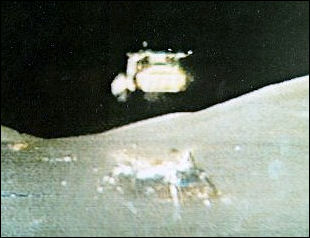|
A panorama of lunar history is captured in this view looking
south over the Valley of TaurusLittrow. A huge fragmented
boulder had rolled almost a mile down the side of the North
Massif to here, Station 6 on our traverse
(see here).
Our LM and its light area of surface alteration can be seen
on the photo about an inch to the right of the top point
of the boulder. That's me at the left. Note the marks of my
sampling scoop on the debris resting on a slanting surface
of the boulder at left. Gene Cernan took the photos from which
this mosaic was assembled.
|






